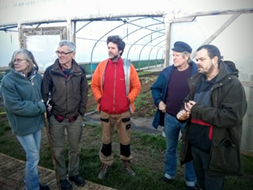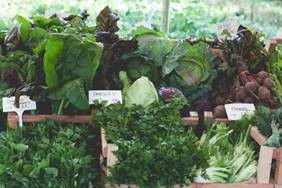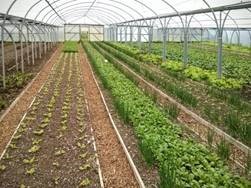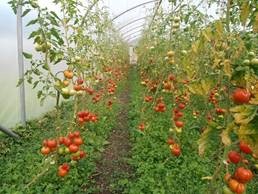Case study 24: United Kingdom: Crop diversification in protected vegetable systems
Cluster 5: Diversification of vegetable cropping systems
How can we introduce more diverse crops from protected rotations to different market channels? Many horticultural businesses in the UK are interested in driving the diversification of their protected cropping systems (polytunnels and greenhouses) and are trying out novel crops or heritage varieties. Taking the whole value chain into account, from seed availability and technical growing challenges to marketing and selling the produced vegetables, this case study has taken a closer look at consumer relations and communication.




What were the main problems underlying the emergence of the case study?
Consumer awareness of the multiple benefits arising from more diverse cropping systems (e.g. environmental and societal health) is often quite low, and purchases are frequently driven by price or convenience. Tackling this question from three different perspectives, this case study will follow the innovation strategy below:
How was the problem addressed and which actors were involved?
The case study has
a) worked with consumers and customers of the businesses involved, engaging individuals from the main marketing channels that are used: e.g. a box scheme, farm shop, farmers’ market, etc. The customers from the various channels were invited to one event per year, where the new crops and products arising from the diversifying system in polytunnels will be introduced. These workshop-style events: 1) increased consumer knowledge about new crops (e.g. sharing recipes, cooking demonstrations, taste tests and comparisons of varieties), 2) explored their willingness to pay for new products, and 3) increased consumers’ relation to the grower and the farm where their food is produced, ultimately enhancing their understanding of crop diversification and the related public goods and general health benefits.
b) worked with a group of UK growers to establish a network of knowledge exchange around this theme. The group met regularly throughout the project period to share knowledge and compare their experiences with: 1) marketing of new varieties (incl. heritage varieties), 2) introducing new crops to the market or to their customers, 3) increasing consumer engagement and communication, 4) technical obstacles of growing new, or a higher diversity of crops, 5) seed availability, 6) identifying suitable green manures or intercropping approaches, etc. Over the 5 years of the project, the members of the network committed to increasing their attention and efforts in the areas listed above and collected information or recorded their experiences in their own businesses to share with the group.
c) monitored agronomic parameters in the diversified protected cropping systems. This includs the collection and analysis of a wider range of agronomic data and sustainability indicators. Examples of information that were collected are: 1) crop diversity – number of species and varieties grown in the polytunnels per season, 2) soil health indicators (soil organic matter, phosphorous, potassium, magnesium, visual soil assessment, infiltration rates, compaction, earthworm counts, mycorrhiza, etc.), 3) productivity - yield and product quality monitoring, and 4) sales, pricing and consumer feedback.
The key challenges identified are: a) barriers to market for some products of diverse cropping systems restrict on-farm innovation; and b) raising consumer awareness and interest: ‘getting the message across’ about why products from more diverse cropping systems are healthier for them, as well as for their environment and ecosystem.
Solution investigated
The aims of the case study were to, together with the grower network, 1) develop practical recommendations and inspiration for other businesses and growers to increase crop diversification in protected vegetable growing systems; and 2) provide insights on the joint learning process of the group by marketing new vegetables and building closer consumer relationships.
Expected outcome
The expected outcomes of the case study were 1) farmer-to-farmer learning on this subject, 2) the co-development of practical recommendations and inspiration together with a network of UK growers to increase the adoption of crop diversification in protected vegetable growing systems; and 3) provide insights on the joint learning process of the group in terms of marketing new vegetables and building closer consumer relationships.
Relevance to the DiverIMPACTS goals
This case study provides an excellent example for innovative and short value chains, selling products at local farmers markets and a veg-box scheme, including its own processed products such as various sauces, pickles, etc. The businesses also organise regular events and fairs for their local communities, catering with their own products and food and building up and maintaining a small network of actors. This enables the study of marketing models or strategies that successfully support such diverse businesses in the food sector.
Case study legacy
Funding is being sought to enable the ‘Kernow (Cornwall) Diversity and Agroecology Network’ to keep going – Organic at the Heart and the case study Leader are building relationships to progress collaborations with other local organisations. The intention is that the case study group continues in two local groups. This will enable more on-farm contact but both networks will remain in dialogue with each other.
Part of the objective of the new network in Cornwall is for practical learning about diversity and agroecology, but also building on conversations from the final meeting looking at how to build more direct connections and relationships between growers to enable practical collaboration to overcome supply chain barriers - on transport / storage and processing to access retail / catering etc., building on findings from DiverIMPACTS work package 6 and case study 15.
Further information
Links
- organicresearchcentre.com: Project: Organic at the Heart
Case study team
- Katie Bliss, ORC, case study leader
- Rowan Dumper-Pollard, ORC, case study monitor
 tap and then scroll down to the Add to Home Screen command.
tap and then scroll down to the Add to Home Screen command.